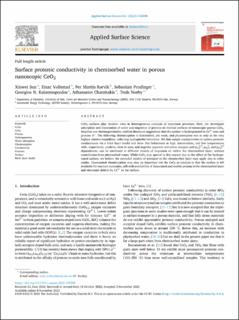| dc.contributor.author | Sun, Xinwei | |
| dc.contributor.author | Vøllestad, Einar | |
| dc.contributor.author | Rørvik, Per Martin | |
| dc.contributor.author | Prodinger, Sebastian | |
| dc.contributor.author | Kalantzopoulos, Giorgios N. | |
| dc.contributor.author | Chatzitakis, Athanasios | |
| dc.contributor.author | Norby, Truls | |
| dc.date.accessioned | 2023-01-16T14:01:26Z | |
| dc.date.available | 2023-01-16T14:01:26Z | |
| dc.date.created | 2022-12-15T17:06:26Z | |
| dc.date.issued | 2023 | |
| dc.identifier.citation | Applied Surface Science, 2023, 611, 1-12. | en_US |
| dc.identifier.issn | 0169-4332 | |
| dc.identifier.uri | https://hdl.handle.net/11250/3043773 | |
| dc.description.abstract | CeO2 surfaces play decisive roles in heterogeneous catalysis of important processes. Here, we investigate adsorption and dissociation of water and migration of protons on internal surfaces of nanoscopic porous CeO2. Sorption and thermogravimetry confirm literature suggestions that the surface is hydrogenated to Ce3+ ions and protons H+. The following chemisorption is dissociative, yet weak, and physisorption sets in only at the very highest relative humidities, reflecting hydrophobic behaviour. We link sample conductivities to surface protonic conductances via a brick layer model and show that behaviours at high, intermediate, and low temperatures with, respectively, positive, close to zero, and negative apparent activation energies and pH2O^(1/2), pH2O^1, and pH2O^(3/2) dependences, can be attributed to different models of migration all within the chemisorbed layer, without contribution from physisorbed water. While CeO2 may special in this respect due to the effect of the hydrogenated surface, we believe the extended models of transport in the chemisorbed layer may apply also to other oxides. Unsaturated chemisorption may play an important role for CeO2 as catalyst in that the surface is left available for reactant molecules, still with availability of dissociated and mobile protons in the chemisorbed layer and electronic defects by Ce3+ in the surface. | en_US |
| dc.language.iso | eng | en_US |
| dc.publisher | Elsevier | en_US |
| dc.rights | Navngivelse 4.0 Internasjonal | * |
| dc.rights.uri | http://creativecommons.org/licenses/by/4.0/deed.no | * |
| dc.subject | Brick layer model | en_US |
| dc.subject | Surface | en_US |
| dc.subject | Protonic | en_US |
| dc.subject | Conductivity | en_US |
| dc.subject | Chemisorption | en_US |
| dc.subject | Water adsorption | en_US |
| dc.subject | Hydrogenation | en_US |
| dc.subject | Porous | en_US |
| dc.subject | CeO2 | en_US |
| dc.subject | Ceria | en_US |
| dc.title | Surface protonic conductivity in chemisorbed water in porous nanoscopic CeO2 | en_US |
| dc.title.alternative | Surface protonic conductivity in chemisorbed water in porous nanoscopic CeO2 | en_US |
| dc.type | Peer reviewed | en_US |
| dc.type | Journal article | en_US |
| dc.description.version | publishedVersion | en_US |
| dc.rights.holder | © 2022 The Author(s). Published by Elsevier B.V. | en_US |
| dc.source.pagenumber | 12 | en_US |
| dc.source.volume | 611 | en_US |
| dc.source.journal | Applied Surface Science | en_US |
| dc.identifier.doi | 10.1016/j.apsusc.2022.155590 | |
| dc.identifier.cristin | 2093985 | |
| dc.relation.project | Norges forskningsråd: 280868 | en_US |
| dc.relation.project | Norges forskningsråd: 257653 | en_US |
| dc.relation.project | Norges forskningsråd: 237922 | en_US |
| dc.source.articlenumber | 155590 | en_US |
| cristin.ispublished | true | |
| cristin.fulltext | original | |
| cristin.qualitycode | 1 | |

